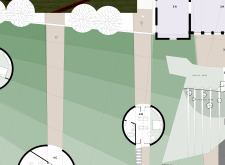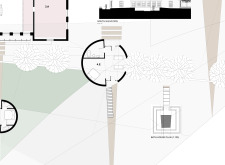5 key facts about this project
From a design perspective, the project showcases a blend of angular and organic forms, creating a visually appealing contrast that draws attention while maintaining harmony within the landscape. The pyramidal structure at the center of the design serves as a focal point, likely functioning as a gathering place or exhibition area. This choice of shape not only enhances the aesthetic character of the project but also utilizes natural light effectively, fostering an inviting atmosphere for visitors and occupants.
An essential element of this architectural project is its material palette. Utilizing materials such as brick, glass, and concrete ensures a balance between durability and aesthetic value. The application of brick adds warmth and permanence to the structure, grounding it within its setting, while large expanses of glass facilitate transparency and connectivity between interiors and the surrounding environment. This thoughtful combination allows for natural light to flood the space, further enhancing the human experience within.
Concrete surfaces and pathways are designed with care, providing a modern touch that reinforces the structural integrity of the project. These pathways connect various areas, including landscaped zones that are intentionally designed to blend into the environment. The use of soft landscaping isn’t merely decorative; it enhances biodiversity and promotes sustainability, integrating the architecture with the natural ecosystem.
Unique design approaches are evident throughout the project. The organization of spaces reflects a clear understanding of user dynamics, where private and public areas are distinct yet interconnected. Circular forms are utilized to create private spaces, promoting a sense of openness and encouraging interaction within smaller groups while retaining intimacy. This thoughtful spatial organization supports the project's goals, enabling it to cater to various activities, from communal gatherings to solitary pursuits.
The design also takes into account the topography and existing landscape features, ensuring that the built environment does not overpower the natural setting. Elevated walkways and strategically placed openings offer views of the landscape, encouraging users to appreciate their surroundings. The architectural elements not only fulfill functional requirements but also serve to enhance the overall experience, allowing users to connect with both the building and the environment.
The combination of these design elements and ideas culminates in a project that is not only visually appealing but also serves practical purposes effectively. The balance between form, materials, and spatial organization exemplifies thoughtful architecture that respects its context. For those interested in further understanding the intricacies of this architectural project, I encourage you to explore the architectural plans, sections, and designs included in the project presentation. This exploration will provide deeper insights into the design rationale and the unique elements that define this architectural endeavor.


























